Travel with Osher!
Spring/Summer 2025

The Journal | Volume 35, No. 1
Contents
In Search of Switzzeltoots
By Melinda Gamble Kramer

Wiedlisbach childhood home at
Stierenweidweg 5 is still inhabited.
It started with an email from my first-cousin Peggy on August 3, 2019, in answer to some questions about our grandmother, Lena Bohner Gamble. It finished on September 22, 2024, in Wiedlisbach, Switzerland, at a grand gathering of relatives we didn’t know we had. But let me begin at the beginning.
Growing up, I was aware that my paternal grandmother was Swiss. She occasionally spoke a strange language, especially with my great-aunts, and sometimes when perturbed she would mutter “Ach, was!”
We grandchildren thought Grandma was swearing in German (very exciting!), but the phrase actually translates as a mild “oh, what now!” (I still like our version best.) At family reunions the Bohner sisters chatted in what they called “Swizzletoots,” and occasionally they would sing and yodel together (extremely exciting for us grandkids).
Of course, as is too often the case, none of us thought to learn the facts behind our Swiss connections until the Bohner girls were gone and their sons and daughters as well.
Fast forward to
February 6, 2024
“Hello Mrs. Hill. With your information we were able to identify your family. Johannes and Anna Maria Bohner-Anderegg lived in Wiedlisbach in the house at Stierenweidweg 5 from 1864 to 1897. They had 9 children. Johannes [Edward Johannes] was the eldest son and Elise the youngest daughter. According to the Burger Register, a brother (Jakob) also emigrated to America with his family. Our and your Bohner families have not been directly related to each other since the 1700’s.
However, one of Johannes’s brothers, born in 1824, still has descendants in Wiedlisbach in the female line. From a sister (Rosa born 1865) there are descendants in Wiedlisbach. The house where Johannes and Anna Maria Bohner lived still stands today. Best regards, David Bohner, Erhard Bohner, and our families.” [All quoted material has been lightly edited for clarity.]
Bingo! With an inquiry email to Bohner’s Bed & Breakfast in Wiedlisbach, Switzerland, my cousin Peggy had verification of the “original immigrant,” our great-grandfather, recorded as Johannes Edward Bohner at birth (1849) and known as Edward J. Bohner after his immigration to America in 1866 at the age of 17.
By early April Peggy, her sister Joann, Michelle, a second cousin, and Michelle’s daughter Myra were making plans with Marianne, a relative in the “female line,” to visit Wiedlisbach where retired teacher Marianne lives with her husband Joel, a retired minister.
April 7, 2024
“Hi Peggy, When in September were you and Joann thinking of going to see relatives in Switzerland? Gary and I have been talking about a trip to Lucerne this fall. Maybe we descendants could rendezvous in Wiedlisbach to see the Bohner ‘roots.’ Let me know what you think. –Melinda”
April 8, 2024
“Our flight arrives in Zurich on Saturday morning 9/21/2024. We plan on taking the train to Wiedlisbach on Sunday, 9/22/2024, and spending the day seeing the original Bohner family home. We then will take the Glacier Express Alpine tour from Zurich. Meeting up with you on the 22nd in Wiedlisbach would be great.
—Peggy”
Fast forward to
September 22, 2024
Wiedlisbach is a village of a few thousand inhabitants, located in the Aargau valley between Bern and Basel. It backs on low mountains to the north. The high Alps are visible to the south on clear days. Having been met at the tiny Wiedlisbach train station the previous afternoon by David Bohner, Gary and I spent Saturday evening with David, Erhard, and their families enjoying a fondue dinner at a restaurant “up the mountain” from the village. Right out of a Swiss postcard, cows wearing clanking bells meandered down to fresh pastures. That night we stayed at the Bohner B&B, beautifully rebuilt by carpenter David from what had once been the barn attached to a traditional Swiss farm home.
Marianne and Erhard organized a Sunday morning coffee and pastries meet-and-greet where everyone could be introduced to everyone else. Then an unexpected highlight—a lecture and guided walk through the village by local historian Gottlieb Holzer, a retired teacher who has published an illustrated history of Wiedlisbach’s families and homes. His remarks, simultaneously translated by Joel, provided a broader context for our personal family story:
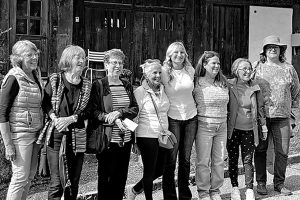
“The family Bohner was on the other side of the mountain before the Reformation, in a town called Matzendorf. In 1529 the Reformation came into this area, but behind the mountain they remained Catholic. The Bohners wanted to be Reformed Protestants, so they came over the mountain. Two centuries later a Bohner living in Farnern, a small village way up the mountain, had the privilege to marry a young woman from Wiedlisbach and so came down by marriage. He was the common ancestor of the Bohners still living in Wiedlisbach. He had five sons, the oldest of whom was named Johannes, who was the father of another Johannes, your great-grandfather, who in 1866 emigrated. Of the five brothers in your great-grandfather’s family, four immigrated to the United States. They didn’t go because they wanted to have fun, but because they had no living in Switzerland. The families were poor, and there were many children; there weren’t jobs or room for everyone. So that’s why they emigrated. It was very common. At times the Swiss government paid for ship’s passage to encourage emigration.”
As Herr Holzer said, it’s an old and common story. Even if a family owned land, repeated subdivision among heirs left little to support descendants after a few generations. Those who stayed cared for their property. Some of our ancestors’ houses still stand, as we saw on our village tour.
Lunch followed—grilled sausages and an amazing number of side dishes for two dozen Bohner descendants, spouses, and children—with musical accompaniment from a local trio dressed in traditional Swiss costumes and playing traditional instruments. The warmth and hospitality extended to us was remarkable, unforgettable. Too soon we walked my American cousins to the station to catch the train back to Zurich.
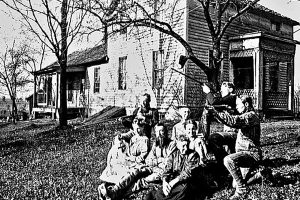
But what of Grandmother Lena? Having found the descendants of the original immigrant and learned our origin story, then what? Johannes (Edward J.) married twice after immigrating to the US. His second wife, Magdalena Mueller, born 1856 in Simmental, Switzerland, was our great-grandmother, mother of Lena and her yodeling sisters. Edward’s obituary notes that he was a cheesemaker living in Winona, Ohio, who died in January 1929 just before turning 80. Lena and her husband Homer Gamble homesteaded in South Dakota in the early 20th century, moved back to an Ohio dairy farm, and raised six children, the youngest of whom was my father, Homer Jr. Well done, Grandma.
I remarked to David Bohner that Swiss German seems different from the Standard German I was taught in school. It is different, he confirmed. Swiss vowel pronunciation is softer with a tendency to shorten words and sounds, whereas consonants are longer and a bit harsher. Linguists classify it as an Allmannic German dialect; Germans call it “Schweiz” or “Schwyzerdütsch.” The Swiss say they speak “Schwiz” or “Schwüzertüütsch.”
And there it is—Swizzletoots explained at last.
Melinda Kramer is a 10-year Osher-JHU faculty member who teaches detective fiction and spy fiction with occasional forays into Jane Austin, Homer, and other authors who strike her fancy.
Back to the Table of Contents
Reflections on Growing Up in the Segregated South
By Millie Rogers
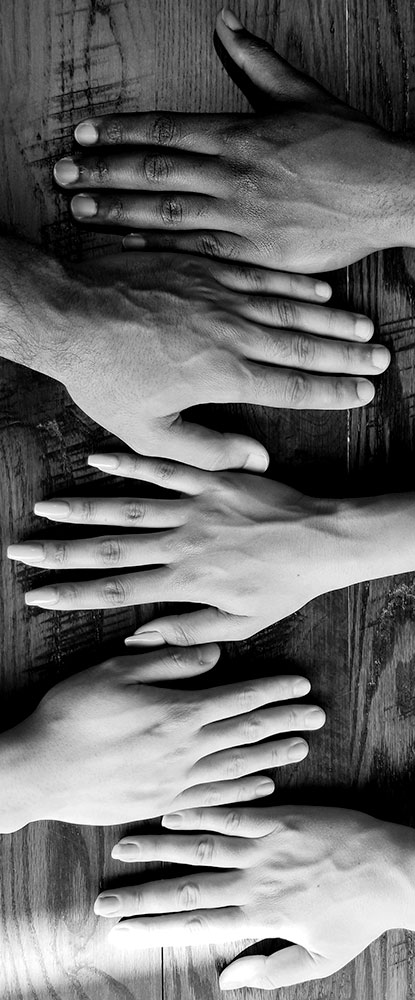 I was born in 1951 in Raleigh, North Carolina. This was the era of separate but equal. Of course, anyone who lived under this system knew that separate was not equal and never would be.
I was born in 1951 in Raleigh, North Carolina. This was the era of separate but equal. Of course, anyone who lived under this system knew that separate was not equal and never would be.
Still, life was good, mainly because my young world existed in the bubble of my segregated community. I never knew that blacks sat in the back of the bus because I never rode the bus. No one ever treated me poorly because my parents never put in a situation where that would happen.
I was about seven years old before I heard a black person called the “n” word. At the time, my family lived close to downtown in a large house with a wide porch. I loved to sit on that porch and watch the world go by.
One lazy, summer day as I sat on the porch, a young black girl, aged 11 or 12, walked up the street headed to the main shopping district. I remember her clearly. She had on a starched blue dress with a white crinoline beneath it. Her white ankle socks and patent leather shoes completed her outfit. A halo of Shirley Temple curls framed her face. To me, she looked beautiful.
As she walked up the street, she passed two white boys close to her in age. When there was a little distance between them, the boys turned around and yelled at her “N*****, n*****, n*****!” My heart ached for her. I felt anger and hurt rising within me. The young girl stopped and turned to confront them. Her face showed no shame or emotion, but just a steely resolve. She calmly said, “God took the time to paint me. He didn’t care enough about you to do anything special.” And with that, she turned and continued on her way. The boys stood there speechless. They looked at each other clearly confused. This was not the reaction they expected. Realizing their words had no power, they also turned and kept walking. That young girl taught me that day to never give my power to other people even as I later endured many other indignities because of my race.
In 1964 Congress passed the Civil Rights law officially ending segregation in the United States. The largest department store in the shopping district closed its restaurant to avoid serving blacks. Following a steep drop in lunch-time business, the restaurant re-opened to all citizens a few years later. During my college years, I worked as a sales clerk at this very store.
One summer I worked in the ladies’ department. Whenever young black women came to the department, the store detective and the department manager showed up to watch them closely. I could feel the white-hot anger radiating from these women. Inevitably, after each woman left, my manager sprinted over to me and asked, “Do you know those girls?” I always smiled sweetly and said, “No, I’ve never seen them before.” And as he walked away, I muttered under my breath, “Do you think I know every black person in this state?”
One day, three young black women strolled into the department. They were loud and seemed intent on drawing attention to themselves. As expected, two store detectives and my manager hustled to the department to stalk them. My Spidey sense told me something was different. These women took pleasure in being followed. I planted myself in a very visible spot on the floor, far from them.
A strong odor of Charlie cologne announced the arrival of three young white women. As the detectives and the store manager focused on the black girls, I stood silently by and watched the white ladies steal dresses, pants, shoes, handbags and anything else they could grab. One young lady, blond and in a mini skirt, saw me watching them and winked at me. I pretended not to notice.
After the Charlie Cologne gang left, one of the black girls took a blouse to the register, purchased it and left with her companions. I did not wait on her. Following their departure, the store detectives and my manager complimented each other on keeping the store safe.
The next day, the entire store hummed with the news of a big robbery, with most of the items stolen from the ladies’ department. Once again, I participated in the same tired, old drill—smiling and repeating, “No, I did not know the young ladies.” I overheard my manager speaking with the head detective, “I don’t know how they got away with it. They were never out of my sight.” Then he looked in my direction and said, “They must have had an inside accomplice.” After saying this, he looked puzzled because he knew I was in plain sight the entire time the women were in the department. The following week, I was transferred to the boys’ department. The robberies in the ladies’ department continued.

Why did I stand by passively as a robbery occurred? Did I resent the constant mistrust and suspicion heaped upon me by the management team? Did I dislike my treatment by some customers who refused my offer of help? While true, neither of these things led to my inaction.
I did nothing because I knew no one would believe a black woman who accused white women of theft.
Back to the Table of Contents
Crowning of Blessed Mother
By Barbara Pallas
 “Oh, Mary! We crown thee….”
“Oh, Mary! We crown thee….”
The closing of so many Catholic churches in the Baltimore City area, where I lived for 60 years, and the turning of the calendar to May, triggers memories of my childhood when Catholic families were preparing their children for their First Holy Communion and the May Procession to honor Mary, the earthly mother of Jesus Christ, who is known to Catholics as the Blessed Mother.
I was in second grade at St. Andrew School, located at Monument and Washington Streets in East Baltimore (one of the first of many Catholic schools and churches that closed in my city in the 1960s). The crowning of the Blessed Mother would be the finale of the annual May procession on the afternoon of the day on which we made our First Holy Communion. I was an excited little girl that day as my white dress and veil made me feel like a bride, and three of my classmates were my “attendants.”
The procession began in the space between the rectory and the church, where meticulously maintained grounds that included various types and colors of roses, as well as other spring flowers, were in full bloom throughout the garden, where the statue of Mary in her blue-and-white gown with arms outstretched was the focal point. Parents and families of the second graders as well as other parishioners and residents of the neighborhood filled the area between the garden and the church where the procession would carry the statue of Mary for her crowning.
My classmates followed behind the statue. I devoutly kept my hands folded and eyes lowered as I led the members of my court to the church. We had practiced this many times, and I knew that after we passed by, everyone would enter the church behind us. We would wait in the back of the church to walk up the aisle.
The pews filled quickly, and the priest completed his welcoming address to a church with no empty seats. Latecomers lined the side aisles as the organist began playing the first of several hymns honoring Mary. Our teacher signaled that we should start our slow procession up the long center aisle. The statue of Mary, which was brought in from outside, had been placed on a table to the left of the altar, inside the sanctuary. Flowers surrounded the table and a wooden step ladder was placed behind it.
All eyes were on our second-grade class of First Communicants as we slowly walked up the aisle with folded hands and smiling faces. The front pews were reserved for our classmates, but my three attendants and I slowly proceeded through the sanctuary gate and took our places to the front and sides of the table holding the statue. Two men from the Holy Name Society stood on either side of the ladder to assist me up the ladder.
We had practiced the crowning procedure many times in the days and weeks before this day, and I was prepared for the duty. My teacher told me, “As soon as the organist begins the hymn, ‘Bring Flowers of The Rarest,’ proceed up the ladder.” The Holy Name man on each side of the ladder took my hand and assisted in the climb.
The deep sound of the organ and the voices loudly singing that beautiful song was my cue to take the crown of flowers offered to me and wait for the moment in the song where the words are, “Oh Mary! We crown thee with blossoms today, Queen of the Angels, Queen of the May.” I stood at the top of the ladder and looked out over a full church of people singing at the top of their voices. Every eye was focused on me. I listened for the words and slowly placed the crown of flowers on the Blessed Mother’s head. A flood of flash bulbs followed and the moment was captured forever by the proud parents and family members of the second-grade First Communicants.

I will never forget that moment. It is a snapshot in my brain that is brought forth every year in May, as the second graders in all Catholic schools make their First Holy Communion. That hymn still brings tears to my eyes when I hear it, and for an instant, I am again that little girl who crowned the Blessed Mother.
Barbara Pallas is a member of the Memoir Seminar at the Johns Hopkins University Osher Institute. This article first appeared in the Op Ed section of the Baltimore Sunpapers in May 2024.
Back to the Table of Contents
New Car 2021
By Mark Weinstein
 In 2021 we bought a Honda Hybrid Accord with all the fancy safety, environmental, communication, and entertainment equipment that could possibly be jammed into a 3400-pound hunk of metal (or is it plastic?). This was not an easy decision, considering our prior rule was to replace a car only if the old one either broke down completely or was stolen.
In 2021 we bought a Honda Hybrid Accord with all the fancy safety, environmental, communication, and entertainment equipment that could possibly be jammed into a 3400-pound hunk of metal (or is it plastic?). This was not an easy decision, considering our prior rule was to replace a car only if the old one either broke down completely or was stolen.
Our 2009 Honda was in perfect running order, disregarding a popping, crackling sound from the brakes, but only if the temperature was above 85 degrees. Turning up the radio took care of that.
It’s true, the old girl also had a few blemishes, from errant garage pillars pouncing unannounced. I regard these marks as badges of honor and experience. One disadvantage of a new car is the lack of these creases, leaving you tense and in constant fear of acquiring them. Once you do, however, the tension disappears, and other drivers keep their distance to avoid the maniac. Something like a dueling scar.
Our momentous decision to get a new vehicle was made principally to acquire all the safety gewgaws before we lost our mental capacity to operate them.
This meant mastering an alphabet soup of: HUD ( head-up display), PCS (pre-collision system), PD (pedestrian detection), LDA (Lane departure alert), BSM (blind spot monitor), RCTA (rear cross-traffic alert when in reverse), SI (Slip indicator), RCD (rear camera detection), RSA (road sign assist), TPWS (tire pressure warning system), and last but not least the ever popular PKSB (parking support brake). This list doesn’t even include the navigation, voice control, fuel monitoring gauge, or the audio entertainment center, which was a volume unto itself. We were so busy being “helped” and distracted by this onslaught of electronic wonders that we nearly collided with oncoming traffic.
And there is something eerie about having an electronic key fob in your pocket that grants you permission to open the locked door simply by touching the door handle. When you enter, the car plays a little tune of greeting and adjusts your seat according to a position you’ve specified.
With a push of a button, the car starts silently. In the old days we had to crane our necks to look back, watch out for cows, and hold our foot on the brake at a stop sign. Now, as you back up, sonar detects any vehicle within a block and half, and alerts you with flashing lights, sound, and if you’re still not paying attention, a stern warning: “Watch out, dummy!” If you continue your reckless behavior, the car, for self-preservation, will automatically lock you in and give you a timeout, until you promise to be good.

It has a facial recognition camera that detects if you’re nodding off while driving (this is true) and if you do, it will give you such a smack that you’ll think twice before doing that again, mister! (probably not true, but I haven’t tested that out yet).
These humanizing advances remind me of those folks in nursing homes who merge their automaton pets with living creatures. While our car hasn’t sprouted fur on the outside yet (can’t be sure it won’t), I imagine all cars will in the future. When we add gas or electricity, they will purr contentedly and blink their headlights. As we enter, they will ask us if we’ve had a nice day and if there’s anything they can do to make us more comfortable, like hot chocolate, or a blankie.
Soon it will just be “Home, Mom,” and off we go to dream land.
Back to the Table of Contents
The Incongruous Altar Boy
By Jerry Mulvenna
 When Jim, one of my Washington roommates, asked me to attend a Sunday evening Mass with him, he could not have been surprised by my response. We had attended the same Catholic college in Philadelphia and he knew that, in Catholic parlance, I had “lost my faith” during those years. It was now 1964, three years later, and Jim was now undergoing the same transition process that I had experienced during my college years. He had grave doubts about what he had been taught in religion classes and felt guilty about having these doubts. Feeling guilt was second nature to Catholic boys in the 1960s. Every time you thought about what was under Mary Maguire’s skirt or fondled your private parts you committed a mortal sin which would, unless confessed, send you to Hell for all eternity. The Catholic parochial school system did a good job of keeping Catholic teenage boys away from contact with the opposite sex at the exact time that their hormones were raging. The average Catholic boy was committing dozens of mortal sins each week.
When Jim, one of my Washington roommates, asked me to attend a Sunday evening Mass with him, he could not have been surprised by my response. We had attended the same Catholic college in Philadelphia and he knew that, in Catholic parlance, I had “lost my faith” during those years. It was now 1964, three years later, and Jim was now undergoing the same transition process that I had experienced during my college years. He had grave doubts about what he had been taught in religion classes and felt guilty about having these doubts. Feeling guilt was second nature to Catholic boys in the 1960s. Every time you thought about what was under Mary Maguire’s skirt or fondled your private parts you committed a mortal sin which would, unless confessed, send you to Hell for all eternity. The Catholic parochial school system did a good job of keeping Catholic teenage boys away from contact with the opposite sex at the exact time that their hormones were raging. The average Catholic boy was committing dozens of mortal sins each week.
I tried ridicule. Jim had already begun the process of missing an occasional Sunday Mass. I tried to convince him that one more mortal sin would not make any difference. I told him that under no circumstances would I attend Mass with him but, if he decided to go, to be sure to say a prayer for me. Jim persisted. He said that, if I attended Mass with him, he would buy dinner for me afterward. My resolve began to weaken. Jim was always a little tight-fisted, and I was not going to sit through a 45-minute Mass for a dinner at McDonalds. After a few minutes of haggling, we finally agreed on dinner at the Astor, a Greek restaurant in downtown Washington, and off we went to Mass.
We arrived at the church at 4:50 p.m, and found that the Mass did not begin until 5: 30 p.m. I did not want to spend almost 2 hours in the church including both the waiting time for the Mass to begin and the length of the Mass. We were the only two people in the church. Jim investigated and found that the evening Mass did not begin until 7:30. I told Jim that the deal was off. I was not going to sit in a church for almost two hours. Jim told me that if I would wait in my car for him, he would still honor his commitment to buy me dinner. I reluctantly agreed.
Sitting in my car was boring and uncomfortable. I decided to return and join Jim in church. It had been years since I had attended a Catholic Mass. It might be interesting to see if any of the Mass rituals had changed in the years that I had been away. As I walked through the church vestibule, I felt a hand on my shoulder. It belonged to a priest. He said “Son, do you know how to serve as an altar boy?”
Five minutes later, the doors of the sacristy opened. Out came the priest followed by a solemn-faced altar boy with his hands folded in prayer. I had no idea of what to expect from myself at the beginning of the Mass. It had been more than 10 years since my last altar boy assignment. There had been no time to rehearse and I didn’t want to make a fool of myself in front of the congregation. It turned out that I had no need to worry. I quickly discovered that I had not lost any of the talents required for a good altar boy. The Latin responses came easily to my mind. I had no need of the cue cards used by many altar boys. I effortlessly performed all the tasks of the two altar boys that normally served at Mass. My demeanor was beyond reproach. I was once again the pre-teenage boy who had served at the Masses celebrated by Father Conway. When the priest and I returned to the sacristy after Mass, he graciously thanked me and said that he was fortunate to find such a competent substitute at the last minute. I told him that I was glad to be of service.
Jim was standing by my car as I approached it. I once again put on my solemn face and folded my hands. Jim doubled over in laughter. I said, “Bless you, my son. You owe me a dinner.”

At dinner that evening, Jim remarked that my altar boy performance was flawless and asked how I could do so well in a matter about which I cared so little. I replied that when something is implanted into your brain at a very early age and it is reinforced by every authority figure that you come in contact with during your childhood, it is very difficult to blot it out of your memory even after you cease to believe it. The food at the Astor that night was delicious, and I shall remember that day the rest of my life.
Back to the Table of Contents
My Grandfather
By Linda Middlestadt
 One day after a spring snowstorm, the sun came out, and the snow still gleamed white and pure, a perfect day for a walk. And as I walked, I remembered the old poem, “Over the river and through the woods, to Grandfather’s house we go; the horse knows the way to carry the sleigh through the white and drifted snow”—which got me reminiscing….
One day after a spring snowstorm, the sun came out, and the snow still gleamed white and pure, a perfect day for a walk. And as I walked, I remembered the old poem, “Over the river and through the woods, to Grandfather’s house we go; the horse knows the way to carry the sleigh through the white and drifted snow”—which got me reminiscing….
I really did go “through the wood to Grandfather’s house.” My mother’s father lived alone a mile or two from the house where I grew up. He had a small white one-room house on a shore lot by the cove off our river, the Bird River. It was solid and old-fashioned, with a white plank door and iron hinges and a strange iron handle. Mother would give me some leftover food and Grandpop’s mail and his Machinist newsletter, and I would walk up the road, and yes, through the wood, to his house. I would knock on the door, very loudly, because Grandpop was quite deaf and rarely wore his hearing aid. He would open the door a crack, take the packages, hold up one finger which meant “Wait,” mutter “Eh, Linda,” and go back into his house. A moment later he would reappear with some candy. He would close the door, and I would walk home.
You see, Grandpop was a hermit. Everyone said how mean he was. He named his mongrel dog Marie after his neighbor. The dog was female, so you can imagine the implication. His wife, my grandmother, had left him when my mother was 16. She was a loving lady, my Grandmother, and eventually married a wonderful man, my step-grandfather who used to read the comics to me as I sat on his lap.
From my earliest memories, Mother had cared for her father, taking him to the grocery store and wherever else he had to go, always reminding him to zip his fly. When he got too old to stay alone, my mother made a room for him at her home. Only my younger brother still lived at home at that time. Once when Mom went on a trip, she asked me to stay at the house to keep things peaceful. I didn’t know what she meant until the first evening when the three of us sat down to supper. Grandpop started cussing at something my brother had done. I was shocked and told him I didn’t care to hear that kind of language. The rest of the dinner was silent. Mother told me that Grandpop had hitch-hiked a ride to the police station to turn my brother in for stealing his tools. Of course, the police just called my mother, who had been in no hurry to go pick him up.
Grandpop had fought for the German army and been wounded in World War I; he married my Grandmother in 1917. They immigrated from Germany in 1925 when my mother was 5. He was a machinist and credited the union with saving his job during World War II. He lived on Social Security from the age of 66 until his death at 94. He died alone in the back bedroom at my mother’s house. She called the authorities to come for his body, and then continued with her bridge party.
And so ended my cheerful reminiscing of the walk through the woods to the strange man that was my grandfather.
Back to the Table of Contents
The Gambler
By Jeanne Marie
Randall Wills
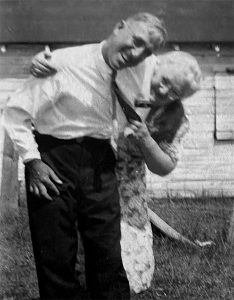
“Grandpa won Grandma’s diamond ring in a card game.” In my father’s stories, Grandpa was a winning card gambler in his youth.
Hiram Edward Randall held my grandmother, Jesse Adaline Phillips on his lap when she was a toddler. The two families were friends in Armada, Michigan and little Hiram was already smitten with this adorable, curly-haired baby girl. Her hazel eyes sparkled and snapped with intelligence and spirit as she looked directly into a person’s eyes.
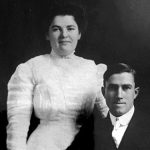
Although Hiram indeed won Jesse’s diamond ring in a card game, before she accepted his proposal, she made him promise never to play cards nor gamble again if she married him. Jesse was not to be defied. Hiram was a man of his word.
Jesse’s sister, my great Aunt Sade, visited the family every December and always brought a deck of cards with her. She must have been a beloved rascal! My father and his siblings would play card games with their Aunt Sade for the duration of her visit. After three weeks, Aunt Sade would leave. The kids would continue to play games for a while with the cards she always left behind, but somehow those cards would mysteriously disappear from the house. The next year Aunt Sade would arrive with another new deck of cards in hand and the story would repeat itself.
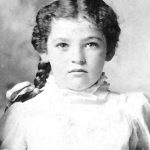
Hiram traveled from town to town surveying properties and drawing official fire maps for the Sanborn Map Company. He wore a trench coat and a fedora as he walked around pacing out distances between buildings and making notations on his sketches. Suspicion mounted in the US during the buildup of WWII in Europe. An unknown man arriving in town wearing a trench coat, intently drawing maps with a hat drawn low over his forehead caused alarm. Hiram was arrested and thrown in jail! After his employment was confirmed, he was released, and the newspaper printed the account, which my grandmother kept in her possessions and passed on to my father, which he passed on to me.
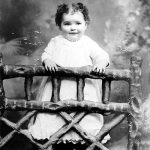
Hiram died suddenly and unexpectedly in June of 1944 at the age of 58. His son Bob, my father, was sent home from boot camp with 10 days furlough to bury his father and get the family’s affairs in order before shipping out to fight in the WWII European Theater as part of General Patton’s Third Army. Was the heart attack that killed my grandfather brought on in part by the fear and anxiety of watching his son prepare to leave the US to fight in a foreign war? My father had asked his family to bring his body back to be buried at home should he fall in battle in Europe.
My sister talks to spirits. She asks questions in conversations and can imagine what they might say much in the same way my daughter as a mere kindergartener could already predict and intuit what her grandparents would say and what they would be doing whenever we arrived at Grammy’s house. My sister has concluded, “Grandpa had to be there to push Dad down into that foxhole so he could survive, and we could be born.” Well, something made my father end up on the ground in the foxhole, surviving the horrific casualties surrounding him.

I never met my grandfather, and my mother never met her father-in-law. I know my grandfather only through my father’s stories. My father marveled at the intelligence he witnessed in his father. Gambling at cards was only a brief, passing antidote in my father’s stories, but one that I intend to explore further now that I am learning to play duplicate bridge. “Grandpa, how did you learn to remember all the cards that have been played?” Can I channel my grandfather for card games? I need to start talking to spirits.
Back to the Table of Contents
Acute, Circumflex, and Grave
By Charles Fortin*
In high school Gerry was a friend and one of the smartest kids I knew. Father Superior had assigned us both to work in the library where I learned the rudiments of Dewey. I also developed the skill of removing ragged book covers and gluing on new colored canvas-like fabric.
This required cutting and tucking in the spinal binding with a plastic tongue-depressor-like tool. Then with white indelible ink I would carefully hand label each book with title and catalog number, and then, once dried, brush each refurbished volume with clear shiny varnish. I still recall the holy high.
 Gerry was a lightning-fast reader. In fact, he turned pages with each breath. I would give it a try. The shelves contained a whole set of Shakespeare in tiny separate hard-covered blue volumes that I noticed he was consuming one after the other. Following his example, I immersed myself and began stuffing my brain with seeming gibberish of metaphor and rhetoric couched in the Bard’s iambic pentameters. But I plowed ahead and began to take pride that I had found reading and a modicum of pleasure in the most unusual and challenging of places.
Gerry was a lightning-fast reader. In fact, he turned pages with each breath. I would give it a try. The shelves contained a whole set of Shakespeare in tiny separate hard-covered blue volumes that I noticed he was consuming one after the other. Following his example, I immersed myself and began stuffing my brain with seeming gibberish of metaphor and rhetoric couched in the Bard’s iambic pentameters. But I plowed ahead and began to take pride that I had found reading and a modicum of pleasure in the most unusual and challenging of places.
Still, pokey as a reader, I pushed myself to go faster and checked out a book with drills to speed read, recall series of numbers, and increase vocabulary. At the same time, I also disciplined myself to a boot camp regime of learning to type on a manual typewriter, practicing sequences of key strokes repeatedly. This exercise also had the effect of enhancing my spelling aptitudes as I was beginning to make peace with words and ideas on the page.
Soon thereafter, however, I inexplicably entered the dark ages. This was a time when stained-glass windows told the picture stories of the gospel without the interference of words for the illiterate. I was relieved and overjoyed when a following page displayed a picture rather than more words to contend with. Compared with others, fortunately, my own crisis in quest of literacy was relatively short lived.
Saint John of the Cross entered into his dark night of the soul only to emerge some 45 years later. Mother Theresa broke the record from 1948 to 1997, the year she died. Mine began after freshman year of high school and dawned mercifully during my last year of college. In the meantime, I had not advanced much beyond Catcher in the Rye and the bawdy Canterbury Tales.
Oh, did I fail to mention that I shunned poetry? Don’t keep me guessing and feeling stupid not having a clue about what is going on. I was impatient and it bored me because I didn’t get it, too elliptical and steeped in evasive notions hidden behind historical and allegorical references that, of course, I didn’t bother to explore. Just come out and say it without that all that imagery and feeling stuff. The Spoon River Anthology—now that’s poetry.
It’s not that I wasn’t in contact with books. During my years of literary discontent, thanks to the dictates of my academic advisor, my education was humanistic in the extreme. During my first two years of college, each semester was reduced exclusively to only four courses, all languages. I shouldered a boatload of classical tomes as well as modern German.
You name it. Cicero, Horace, Quintilian, Plato, Sophocles, Xenophon, Homer, Thomas Mann and Rainer Rilke. Among the Latin offerings, Winnie Ille Pu was the most challenging. That’s right. Oh yes, for good measure, my bookbag included works of English rhetoric and literature every semester along the way. And for every time-honored literary masterpiece I cradled its companion dictionary terrorizing my every waking hour.
Literary richness largely escaped me as I concentrated on the minutia of word meanings, grammar, placing correctly the Greek circumflex along with its troublesome brothers, acute and grave. Did I fail to mention the perplexing dactylic hexameter?
My Greek professor advised: if you know the words, you’ll get a 100. Of course he always threatened with the surprise sudden death quizzes. If I got just one Greek accent wrong, zero. In other words, while exposed to the mechanics of literature, I battled it defensively.
Get the word’s meaning right, get the accent right, and oh by the way, be sure to get your mythology and genealogy straight. Know who was a god, who was human, who occupied the space in between, and especially who was screwing whom, and those associated gory revengeful consequences. A casualty of this barrage of languages, my spelling skills reverted back to those of a third grader.
Finally, in subsequent years, after a myriad of courses in Philosophy and Sociology (my major de jour), I emerged from my dark night and entered the bright sunshine of Senior Seminar which required frantic reading, writing, and discussion, one book per week for two semesters.
Gone was the terror of learning grammar, conjugating verbs, affixing accents, hauling around the extra weight of foreign language dictionaries, and deciphering the arcane intricacies of incestuous antiquity. As a reader I finally took the offensive, probing to learn what meaning the author intended to convey and how I felt about it. The burden of proof shifted to the author to take me to a place I had never been before. I would find myself somewhere beyond the weathered pages of the final obsolete volume of Funk & Wagnalls (the only books proudly displayed in our home) and the cozy confines of my midwestern high school library.
*Initially as Peace Corps Volunteer in Salvador, Bahia, Brazil and later, for another 17 years Dr. Fortin taught, carried out research, and administered graduate studies at the Federal University of Pernambuco in the Northeast city of Recife.

He earned an undergraduate degree from the University of Notre Dame (Indiana), master’s at the University of Wisconsin-Madison, and doctorate in international development at the University of Sussex near Brighton in the UK. A subsequent career took him to Washington, DC, with the Inter-American Development Bank where he evaluated the environmental impacts of projects supported by the IDB in Latin America.
More recently, for six years he has taught Philosophy, Critical Thinking, and Ethics courses at Carroll County Community College in Westminster. Currently, as Adjunct Professor, he teaches Basic and Advanced Portuguese both privately and through Baltimore County Community College.
Back to the Table of Contents
The Cute Couple
By Jim Herrell
 Thursday, February 14, 1957, a date which shall live in infamy, at least within the egocentric confines of my adolescence. In Texas, boys could drive at 14. I, the youngest ninth grader, watched one after another classmate get his license, enabling him to have “car dates,” meaning he could pick up his date in the family car and go anywhere and do anything, unencumbered by parental oversight. Few girls would date ninth-grade guys who couldn’t drive, and in four more days, I would no longer be one of those guys.
Thursday, February 14, 1957, a date which shall live in infamy, at least within the egocentric confines of my adolescence. In Texas, boys could drive at 14. I, the youngest ninth grader, watched one after another classmate get his license, enabling him to have “car dates,” meaning he could pick up his date in the family car and go anywhere and do anything, unencumbered by parental oversight. Few girls would date ninth-grade guys who couldn’t drive, and in four more days, I would no longer be one of those guys.
My girlfriend, Suzanne, lived a block away. We attended the same church, carpooled to and from Fulmore Junior High, and our mothers were friends. Suzanne was the first girl to accept my invitation of a date, the first whose hand I held, and the second I kissed (although the first who wasn’t passing out kisses to all the guys on the bus returning from a junior high band trip). For months, she and I, always chauffeured by a parent, had gone together to parties, picnics, hayrides, dances. We were never “going steady,” but we were widely considered a couple.
And a cute couple we were, said our mothers. When there was an event to go to, they would proclaim, “You’re such a cute couple; you should go together,” and it would be so. During the 18 months of our couplehood, Suzanne was almost the ideal girlfriend, attractive, smart, and socially acceptable enough that other guys didn’t mock me for dating her. But she did not stir me in ways I had hoped to be stirred. More experienced friends had led me to believe there should be more to being a cute couple than, well, being a cute couple.
None of this, however, is what made Suzanne so important to my life. It was her innocent participation in the St. Valentine’s Day disaster.
When I arrived home from school that fateful Thursday, my mother handed me a red, heart-shaped box of candy and told me to take it and a cheesy card to Suzanne. Finding the idea humiliating, I protested. Mother reminded me that Sunday I’d turn 14, and if I hoped to be allowed to drive after getting my license on Monday, she and Daddy had to be certain that I was responsible and obedient. Thus warned, I hopped on my bike to deliver the stupid things.
Suzanne was outside checking the mail when I pedaled up, so instead of coasting into her driveway and dismounting like a normal person, I decided to show off, riding directly into the lawn from the unpaved street and across the rain gully, leaping from my still-moving bike, entangling the cuff of my jeans in the chain, falling into the bike, and breaking my right ankle. The break required a bulky plaster cast ascending to mid-calf, so I couldn’t take the driving test the following Monday, and before the cast came off, Texas raised the driving age to 16. For the rest of the school year, I remained one of the few ninth-grade boys at Fulmore who couldn’t drive, and the next year I was the only 10th-grade boy at Travis High who couldn’t drive, and the next year I was the ONLY SUCH 11TH GRADER ON THE WHOLE BLEEPING PLANET!
At the end of ninth grade, I told Suzanne our cute couple days were over. Early in 10th grade, another girl and I occasionally double-dated with a friend who could drive, but a humiliating incident ended that practice. The friend and his date drove me and mine to a hayride, but for reasons I’ve forgotten, my father picked us up afterward. Alas, there was miscommunication about where he would meet us. As my date and I waited for him for minutes, for hours, forever, I progressed from embarrassment to total mortification. “Don’t worry,” my date said, after my father finally found us and she and I were saying good night on her porch. “Girls have to expect these things when they date boys who don’t drive.” She meant well, but her words were like a punch in the gut. That night, I resolved to date no more until I got my license.
I prolonged the agony on my 16th birthday, when I failed the driving test on some silly technicality (illegal left turn). Texas had a rule that stupid kids who couldn’t pass the test had to wait a week to retake it, so, 16 years and seven days old, six months into 11th grade, I became a legal driver.
That evening, my parents let me take our ‘55 Pontiac to a play rehearsal at school. Ignoring their order to come straight home after dropping off some friends, I chose the long way, down Lund Hill and around Zilker Park. Lund Hill: Steep. Winding. Dark. I lost control of the Pontiac, bouncing into a curb, knocking the front wheels out of line. My parents had a rule that stupid, disobedient kids who banged up the family car couldn’t drive again for a month.
By then, the semester was almost over, and my standing among girls at school had been ruined long ago, but during the summer I began dating girls from the incoming 10th grade class who were unaware of my reputation. By early fall I’d settled-in with a girl who was cute, perky, and, um, stirring.
In 2001, learning from a neighbor that she and Suzanne were friends, my father told her Suzanne and I used to date. The neighbor reported this to Suzanne, who wrote Daddy a note, in which she denied we’d ever dated, saying she only knew me because we carpooled together. What? How could she forget we’d dated? OK, there’s a distinction between having a couple of dates with someone and “dating” that person, but clearly, during our cute-couple days we were dating. The real shocker, though, was her claim that I was their paper boy and had broken my ankle delivering the paper. Come on! Surely, if a boy destroys his life by breaking his ankle bringing a girl Valentine candy, the girl remembers it as one of the great romantic moments in her life, not as a workman’s comp thing.
Ah, well. I guess our cute couple days were no more stirring to Suzanne than to me.
But our mothers never abandoned their hopes. At my uncle’s funeral in 1997, Suzanne’s mother approached as I was talking to one of my uncle’s friends, who asked her, “Do you know Herb’s nephew?” “Know him!” she said. “He was supposed to be my son-in-law!” When the minister at my mother’s funeral in 1999 asked if anyone would like to share memories, Suzanne’s mother related the story of the broken ankle (she got the facts right), and told everyone she and my mother had thought Suzanne and I made such a cute couple, and how disappointed they were that we did not become man and wife.

For years, I considered the broken ankle and its fallout as the worst thing that ever happened to me. Of course, “happened to me” isn’t what happened—I brought it all upon myself by my idiotic behavior, a fact it took me years to accept. But during those years, I viewed it all as a 9 on a tragedy scale of 10. Now, in the ninth decade of a full, happy, fortunate life, I see it as comedy. Of all the horrible things a person can experience, a delayed driver’s license can’t rate more than a 1.5, a notch worse than, say, driving through Nebraska with the radio stuck on a station conducting a Barry Manilow retrospective.
But I still enjoy telling the story as Shakespearean tragedy. Recently, when I inflicted my tale upon house guests, my unfortunate wife, Joan, who’d heard the story at least once too often, and who is all too familiar with my driving, said, “Jim, if you’d gotten your license at 14, you’d never have made it to 16.”
Good point, I had to admit
Back to the Top